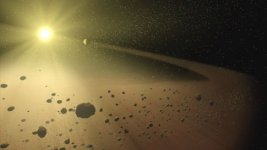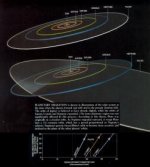Missing space rocks indicate planetary migration
Monday, March 2, 2009
Scientists from the University of Arizona have encountered a strange case of missing asteroids. The asteroid belt between the orbits of Mars and Jupiter, contains millions of rocky objects. Simulations predict a lot more asteroids than actually observed, so that a large part of the asteroid belt "disappeared" to. This would be evidence for an event, that 4 billion years ago. These are the giant planets position changed.
This phase of planetary migration may have led to the violent bombardment of the inner planets, with most craters on the moon arose. At the end of this phase, the giant planets reached their current position and the bombing stopped.
The astronomers have started their research by looking at the distribution of asteroids in the asteroid belt. Astronomers have already in the 19th century a series of "holes" discovered, when only a handful of asteroids as well. This so-called Kirkwood-holes are specific regions in the asteroid belt where the gravity of Jupiter and Saturn the asteroids do wegslingeren. The current orbits of Jupiter and Saturn explained the emptiness of these unstable regions.
The scientists were going back out if the structure of the asteroid belt can be explained simply by the gravitational effects of the giant planets, such as the Kirkwood-holes is the case. Scientists have looked at all the asteroids with a diameter of 50 kilometers or more. All asteroids of this size have been discovered, so the researchers had available a complete waarneemset for their study.
Subsequently, one huge series of computer simulations run, the asteroid belt was filled with a uniform distribution of computer asteroids. Subsequently, the simulations run for billions of virtual years and then look at the results. The conclusion is remarkable: each simulation invariably ended with many more asteroids than actually observed.
When the simulated asteroid belt was compared with the actual asteroid belt, was a remarkable pattern of differences appeared. The belt was simulated well with "inside" of the real belt (on the side of the sun) and the differences were greatest in the "outside" of the real belt (on the side of Jupiter).
Subsequently, the migration of the giant planets simulated. The effects of migrant planets have then resulted in a simulated belt which corresponds well with the asteroid belt as actually observed. The interpretation is that the migration of Jupiter and Saturn have resulted in distortions, many more asteroids are weggeslingerd than would be possible with the current orbits of Jupiter and Saturn.
These results are consistent with other evidence of a remarkable phase in the history of the solar system, where the four giant planets (Jupiter, Saturn, Uranus and Neptune) are much closer together created and then changed his position. Jupiter is closer to the sun shifted and the remaining three migrated outwards, not only the distance to the sun, but also the distance between the planets themselves.
It is not only seriously disturbed the Kuiper Belt (the scattered disk and Oort Cloud arise), but is also the asteroid belt beyond recognition. Now, all asteroids that have remained weggeslingerd somewhere, making the likely culprit is found for the massive impact that the inner planets during this period have suffered.
Source: astrostart
Monday, March 2, 2009
Scientists from the University of Arizona have encountered a strange case of missing asteroids. The asteroid belt between the orbits of Mars and Jupiter, contains millions of rocky objects. Simulations predict a lot more asteroids than actually observed, so that a large part of the asteroid belt "disappeared" to. This would be evidence for an event, that 4 billion years ago. These are the giant planets position changed.
This phase of planetary migration may have led to the violent bombardment of the inner planets, with most craters on the moon arose. At the end of this phase, the giant planets reached their current position and the bombing stopped.
The astronomers have started their research by looking at the distribution of asteroids in the asteroid belt. Astronomers have already in the 19th century a series of "holes" discovered, when only a handful of asteroids as well. This so-called Kirkwood-holes are specific regions in the asteroid belt where the gravity of Jupiter and Saturn the asteroids do wegslingeren. The current orbits of Jupiter and Saturn explained the emptiness of these unstable regions.
The scientists were going back out if the structure of the asteroid belt can be explained simply by the gravitational effects of the giant planets, such as the Kirkwood-holes is the case. Scientists have looked at all the asteroids with a diameter of 50 kilometers or more. All asteroids of this size have been discovered, so the researchers had available a complete waarneemset for their study.
Subsequently, one huge series of computer simulations run, the asteroid belt was filled with a uniform distribution of computer asteroids. Subsequently, the simulations run for billions of virtual years and then look at the results. The conclusion is remarkable: each simulation invariably ended with many more asteroids than actually observed.
When the simulated asteroid belt was compared with the actual asteroid belt, was a remarkable pattern of differences appeared. The belt was simulated well with "inside" of the real belt (on the side of the sun) and the differences were greatest in the "outside" of the real belt (on the side of Jupiter).
Subsequently, the migration of the giant planets simulated. The effects of migrant planets have then resulted in a simulated belt which corresponds well with the asteroid belt as actually observed. The interpretation is that the migration of Jupiter and Saturn have resulted in distortions, many more asteroids are weggeslingerd than would be possible with the current orbits of Jupiter and Saturn.
These results are consistent with other evidence of a remarkable phase in the history of the solar system, where the four giant planets (Jupiter, Saturn, Uranus and Neptune) are much closer together created and then changed his position. Jupiter is closer to the sun shifted and the remaining three migrated outwards, not only the distance to the sun, but also the distance between the planets themselves.
It is not only seriously disturbed the Kuiper Belt (the scattered disk and Oort Cloud arise), but is also the asteroid belt beyond recognition. Now, all asteroids that have remained weggeslingerd somewhere, making the likely culprit is found for the massive impact that the inner planets during this period have suffered.
Source: astrostart


